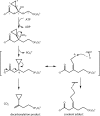Probing ligand-binding pockets of the mevalonate pathway enzymes from Streptococcus pneumoniae
- PMID: 20404339
- PMCID: PMC2898321
- DOI: 10.1074/jbc.M109.098350
Probing ligand-binding pockets of the mevalonate pathway enzymes from Streptococcus pneumoniae
Abstract
Diphosphomevalonate (Mev.pp) is the founding member of a new class of potential antibiotics targeting the Streptococcus pneumoniae mevalonate (Mev) pathway. We have synthesized a series of Mev.pp analogues designed to simultaneously block two steps in this pathway, through allosteric inhibition of mevalonate kinase (MK) and, for five of the analogues, by mechanism-based inactivation of diphosphomevalonate decarboxylase (DPM-DC). The analogue series expands the C(3)-methyl group of Mev.pp with hydrocarbons of varying size, shape, and chemical and physical properties. Previously, we established the feasibility of a prodrug strategy in which unphosphorylated Mev analogues could be enzymatically converted to the active Mev.pp forms by the endogenous MK and phosphomevalonate kinase. We now report the kinetic parameters for the turnover of non-, mono-, and diphosphorylated analogues as substrates and inhibitors of the three mevalonate pathway enzymes. The inhibition of MK by Mev.pp analogues revealed that the allosteric site is selective for compact, electron-rich C(3)-subsitutents. The lack of reactivity of analogues with DPM-DC provided evidence, counter to the existing model, for a decarboxylation transition state that is concerted rather than dissociative. The Mev pathway is composed of three structurally and functionally conserved enzymes that catalyze consecutive steps in a metabolic pathway. The current work reveals that these enzymes exhibit significant differences in specificity toward R-group substitution at C(3) and that these patterns are explained well by changes in the volume of the C(3) R-group-binding pockets of the enzymes.
Figures




Similar articles
-
Mevalonate analogues as substrates of enzymes in the isoprenoid biosynthetic pathway of Streptococcus pneumoniae.Bioorg Med Chem. 2010 Feb;18(3):1124-34. doi: 10.1016/j.bmc.2009.12.050. Epub 2009 Dec 24. Bioorg Med Chem. 2010. PMID: 20056424 Free PMC article.
-
Streptococcus pneumoniae isoprenoid biosynthesis is downregulated by diphosphomevalonate: an antimicrobial target.Biochemistry. 2004 Dec 28;43(51):16461-6. doi: 10.1021/bi048075t. Biochemistry. 2004. PMID: 15610040
-
Crystal structure of the Streptococcus pneumoniae mevalonate kinase in complex with diphosphomevalonate.Protein Sci. 2007 May;16(5):983-9. doi: 10.1110/ps.072755707. Epub 2007 Mar 30. Protein Sci. 2007. PMID: 17400916 Free PMC article.
-
Identification, evolution, and essentiality of the mevalonate pathway for isopentenyl diphosphate biosynthesis in gram-positive cocci.J Bacteriol. 2000 Aug;182(15):4319-27. doi: 10.1128/JB.182.15.4319-4327.2000. J Bacteriol. 2000. PMID: 10894743 Free PMC article.
-
Cell compartmentalization of cholesterol biosynthesis.Ann N Y Acad Sci. 1996 Dec 27;804:142-64. doi: 10.1111/j.1749-6632.1996.tb18614.x. Ann N Y Acad Sci. 1996. PMID: 8993542 Review.
Cited by
-
An enzymatic platform for the synthesis of isoprenoid precursors.PLoS One. 2014 Aug 25;9(8):e105594. doi: 10.1371/journal.pone.0105594. eCollection 2014. PLoS One. 2014. PMID: 25153179 Free PMC article.
-
Backbone 1H, 13C, 15N NMR assignments of the unliganded and substrate ternary complex forms of mevalonate diphosphate decarboxylase from Streptococcus pneumoniae.Biomol NMR Assign. 2011 Apr;5(1):11-4. doi: 10.1007/s12104-010-9255-4. Epub 2010 Aug 25. Biomol NMR Assign. 2011. PMID: 20737255 Free PMC article.
-
A Single Amino Acid Mutation Converts (R)-5-Diphosphomevalonate Decarboxylase into a Kinase.J Biol Chem. 2017 Feb 10;292(6):2457-2469. doi: 10.1074/jbc.M116.752535. Epub 2016 Dec 21. J Biol Chem. 2017. PMID: 28003359 Free PMC article.
-
Synthesis of mevalonate- and fluorinated mevalonate prodrugs and their in vitro human plasma stability.Eur J Med Chem. 2015 Jan 27;90:448-61. doi: 10.1016/j.ejmech.2014.11.040. Epub 2014 Nov 22. Eur J Med Chem. 2015. PMID: 25461893 Free PMC article.
-
The Putative mevalonate diphosphate decarboxylase from Picrophilus torridus is in reality a mevalonate-3-kinase with high potential for bioproduction of isobutene.Appl Environ Microbiol. 2015 Apr;81(7):2625-34. doi: 10.1128/AEM.04033-14. Epub 2015 Jan 30. Appl Environ Microbiol. 2015. PMID: 25636853 Free PMC article.
References
-
- Obaro S., Adegbola R. (2002) J. Med. Microbiol. 51, 98–104 - PubMed
-
- Schuchat A., Robinson K., Wenger J. D., Harrison L. H., Farley M., Reingold A. L., Lefkowitz L., Perkins B. A. (1997) N. Engl. J. Med. 337, 970–976 - PubMed
-
- Van Bambeke F., Reinert R. R., Appelbaum P. C., Tulkens P. M., Peetermans W. E. (2007) Drugs 67, 2355–2382 - PubMed
-
- Kyaw M. H., Lynfield R., Schaffner W., Craig A. S., Hadler J., Reingold A., Thomas A. R., Harrison L. H., Bennett N. M., Farley M. M., Facklam R. R., Jorgensen J. H., Besser J., Zell E. R., Schuchat A., Whitney C. G. (2006) N. Engl. J. Med. 354, 1455–1463 - PubMed
Publication types
MeSH terms
Substances
Grants and funding
LinkOut - more resources
Full Text Sources
Other Literature Sources
Miscellaneous

